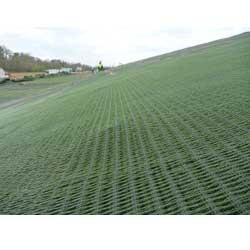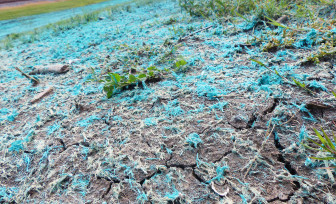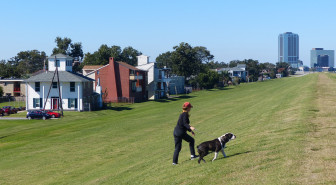When historians look back at the building of New Orleans’ $14.5-billion post-Katrina hurricane protection system, it may come as a jolt to realize that vast amounts of research and debate were focused on a rather humble construction material, yet one engineers say is a key to keeping the whole mammoth project standing during a super storm.
No, not concrete, or steel or the right kind of dirt.
It’s grass – good old Bermuda grass, to be more precise.
Turns out that when this system is overtopped — and the experts say “when,” not “if” — the material the corps is relying on as “armoring” to prevent a repeat of the levee collapses that contributed to 1,400 deaths during Hurricane Katrina may well be the same stuff growing on your lawn.
Yet, some of the corps contractors are having trouble getting the stuff to grow.
“It’s like pulling a thread on a sweater. Once scouring starts at the toe of the levee, the whole thing can unravel, and that’s when you have a collapse.” — Bob Turner, levee engineer
Now, the idea that grass can armor anything, or that anyone could have trouble growing it in a region where residents spend much time and money trying to slow it down, may seem ludicrous. But not to the corps or local levee authorities.
In fact, the Bermuda grass has been the source of deep and longstanding concern. Both the corps and local levee authorities see its potential, but also the possibility that it will leave the system vulnerable to disaster during a large storm.
That has led to questions about whether costly alternatives — porous mats, for example, or slabs of concrete — might be better.
“We are not convinced [plain] grass is the way to go on the levees of this metro area because of the risks associated with a potential failure,” said Bob Turner, an engineer and regional director of the Southeast Louisiana Flood Protection Authority-East.
“When you look at the consequences associated with failure, the costs in human lives and property, then the cost of the resiliency is far and away less than any of those consequences.”
WHY ARMORING?
Armoring earthen levees generally means adding an outside layer to prevent erosion. In the case of this region’s hurricane surge, engineers say, the greatest need for armoring is on the protected – or landward – side of the levees.

While it seems logical that the water side of a levee would be under greater stress from a storm surge and the pounding of its wind-driven waves, engineers say that isn’t the case. The water rises up against the levee covering the grass rather than rushing with force along its surface. The energy of the waves striking the levee face then travels into the levee’s core, rather than ripping apart the grassy surface.
But when a levee is overtopped, water cascades down the landward slope. Its force can begin scouring at any bare patches or holes, then eating into the muddy interior until it collapses.
“It’s like pulling a thread on a sweater,” Turner said. “Once scouring starts at the toe [bottom] of the levee, the whole thing can unravel, and that’s when you have a collapse.”
As Katrina showed, a levee collapse can culminate in disaster, overwhelming the entire flood-protection system.

According to post-storm investigators, if the levees on the Mississippi River Gulf Outlet and Gulf Intracoastal Waterway had been overtopped without collapsing during Katrina, the water that rose to roof levels in St. Bernard Parish and eastern New Orleans might only have been ankle- to shin-deep in most places. Proper armoring, they concluded, could have resulted in an annoyance rather than a deadly disaster.
[module align=”left” width=”half” type=”pull-quote”]“You know how we reinforce concrete with iron rebar? That’s kind of what the roots are doing on the levee. It’s reinforcing the structure of the soil, holding it down.” — Steve Beasley, LSU agronomist[/module]While all levee systems are built high enough to repel surge and waves for a predictable threat, engineers say armoring is still necessary because it’s an inexpensive way to increase protection against the natural threats that exceed expectations.
For example, the New Orleans system is designed to repel the storm surge likely to accompany a so-called 100-year storm, a storm that has a 1 percent chance of occurring in any year. But depending on the storm’s path, overtopping can still occur during such an event, Turner said, and will almost certainly happen during a larger storm.
Recent hurricanes prove how ambiguous storm-surge standards can be. Katrina, Rita, Gustav and Ike, all of which struck Louisiana in the past eight years, exceeded the 100-year surge level. Katrina’s storm surge reached the 400-year level on the Gulf Coast and in Lake Borgne was at the 250-year level.
By armoring the protected side of the levees, Turner said, the metro area could get protection against 500-year storms from its 100-year system. That extra protection beyond the system’s designed strength is what engineers call “resiliency.”
“We saw what happened during Katrina. We believe the risk to human life and property is so great, that we absolutely need that resiliency in this new system,” Turner said.
“And right now, the plan is for that armoring to be grass on earthen levees.”
WHY GRASS?
In some places, impervious materials such as concrete or rocks are the obvious choices for armoring, but not in southeastern Louisiana.
First, the sinking soils on this sediment-starved delta mean levees will have to be raised in the coming years. Adding the extra weight of concrete mats would only increase the frequency of that expensive repair.
Second, it would be too expensive to pour concrete on the hundreds of miles of local levees comprising the region’s flood barrier.
And it turns out that the right kind of grass has many advantages.
“Grass is a natural cover that slows down the velocity of water coming down the back side through the friction of its stems and leaves above the surface,” said Dave Beck, deputy chief of the civil branch at the corps’ New Orleans office. “And its root system acts to bind the soil together to help it resist erosion.”
Bermuda is the best type of grass for these levees, Beck said.
It’s a view shared by LSU’s Steve Beasley, an agronomist brought in by the corps to help contractors solve their grass problems. Beasley is impressed by Bermuda grass because it grows fast in southeast Louisiana, resists drought and insects, and has a dense root system.
“You know how we reinforce concrete with iron rebar?” Beasley asked. “That’s kind of what the roots are doing on the levee. It’s reinforcing the structure of the soil, holding it down.
“And, of course, it’s economical compared to concrete.”
Moreover, when there are problems with grass, it’s relatively simple and inexpensive to correct.
PROBLEMS WITH GRASS
But grass is not without its challenges. From the start of rebuilding the city’s flood defense, some of the corps’ levee contractors have struggled to meet the grass-growing requirements in their contracts. Local flood authorities have complained to the corps for years about the sight of newly-built levees standing naked in heavy rains or sprouting a few mangy patches of grass.
Eventually, the corps called in Beasley to help contractors improve their work.
“Growing grass on levees isn’t as simple as growing it in your yard,” Beasley explained recently as he walked a stretch of the Lake Pontchartrain levee in Kenner.
“You have to realize there are conditions here and challenges that have to be addressed.”
He listed four:
- The dense, clay-rich soil used for the levee
- The variability of local weather
- Salinity in some soils as well as in water blown onto levees during high winds
- Finishing construction after the grass-growing season ends, leaving the new levee naked of natural armoring.
“So there are steps you have to take to get the grass to grow more rapidly, and that’s what I’ve been advising them on,” Beasley said.
The first step was developing criteria for soil that can resist storm surge but still be conducive to growing grass. Beck said each purchase is spec-tested before being delivered to a supplier.
Next came a schedule for quickly seeding and protecting new, bare levees. This includes spraying a layer of mulch over the seeds, which prevents them from blowing away and helps retain moisture.
Then came careful monitoring, including watering and in some cases fertilizing.
But even with Beasley’s guidance, the Flood Protection Authority was so concerned about the poor performance of some contractors that it offered to take over maintenance of many sections even before it was legally required to do so, Turner said.
Beasley, who continues to advise the corps, said some shortcomings can be expected. When you’re dealing with such large expanses of earthen levee, he said, you can expect problems, such as wind-borne saltwater, insects and drought.
Nonetheless, Beasley is encouraged. “These levees have never been in such good shape overall,” he said. “Are there problems? Of course. You’re dealing with hundreds of miles of levee here. Expecting no problems would be like going to the island of Manhattan and saying we don’t want a pothole.”
MATTING MATTERS
But the Flood Protection Authority is worried about more than an occasional pothole.
Grass by itself may stand up under the minor overtopping of a 100-year storm, Turner said. But to protect the city from Katrina-like inundations during larger storms, he said he wouldn’t trust grass unless it is installed with what’s known as “high-performance turf-reinforcing mat.”
A synthetic carpet made with small openings, the mat is laid down on bare levees. When the grass grows through the mat, the material provides a matrix of interlocking support for wide areas of levee.
An upgraded version of the woven willow mats that plantation owners used to reinforce levees centuries ago, the technology has proven effective in erosion control along drainage ditches and streams, but it has never been used to armor levees against storm surge, Turner said.
The corps built a million-dollar overtopping simulator at Colorado State University in Fort Collins, Colo., to evaluate the performance of the mat-supported grass against alternatives such as small concrete blocks and grass in various stages of growth.
Beck said healthy Bermuda grass without the reinforcing mat got the same passing grades as healthy grass or levees armored with concrete blocks. But he cautioned the results were not final.
“The tests were limited, and we didn’t gain a whole lot of knowledge on what works best,” he said.
In fact, the Flood Protection Authority isn’t at all convinced the scientists running the simulator are taking the right approach. Turner said the tests of various alternatives won’t provide definitive information on degrees of resiliency unless they are “deterministic” – which means pushing each option to the point of failure.
“Until you reach the failure point, you don’t know what the limit is,” Turner said. “Until we know that, we won’t have confidence in the level of protection we actually have.”

Turner is concerned that if the corps’ non-deterministic testing shows that plain grass and mat-reinforced grass both survive overtopping, the agency will insist on plain grass to save the estimated $325 million cost of matting the whole system.
Turner’s agency thinks the extra support provided by matting is worth the cost because of enhanced resiliency.
But approval of matting must also await another test: How it stands up to the constant mowing required to keep the grass healthy. The corps is trying to answer that question by using tractor mowers on test sections of matt-reinforced grass.
“What happens when it rains and tractor tires dig into the grass? Will the matting get caught in tires and be ripped up?” Turner asked. “There are still a lot of questions that have to be answered.
“If it works from an operation and maintenance perspective, I’d feel pretty confident [mat-reinforced grass] will provide the resilience we need.
“But we’re still not there yet.”



I’ve always wondered why we don’t use a grass with a more cohesive and dense root mat such as St. Augustine. It seems to also be less prone to dying off during dry whether.
Of course, it seems that lariope or mondo grass would be the best possibility as it’s very dense, spreads easily, roots strongly and deeply, is too thick for weeds to take hold, stays green year round, is drought tolerant, and doesn’t have to be mowed.
It would be more expensive at first, but would have near zero maintenance costs as opposed to the constant attention the current field grass requires.
They should use crab grass instead.
Deep roots are not good. you don’t want the roots to cross a single soil layer and create an entry point for water.